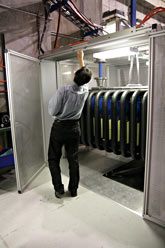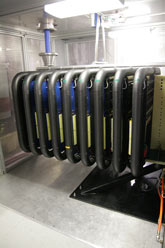
Handy Links
SLAC News Center
SLAC Today
- Subscribe
- Archives: Feb 2006-May 20, 2011
- Archives: May 23, 2011 and later
- Submit Feedback or Story Ideas
- About SLAC Today
SLAC News
Lab News
- Interactions
- Lightsources.org
- ILC NewsLine
- Int'l Science Grid This Week
- Fermilab Today
- Berkeley Lab News
- @brookhaven TODAY
- DOE Pulse
- CERN Courier
- DESY inForm
- US / LHC
SLAC Links
- Emergency
- Safety
- Policy Repository
- Site Entry Form

- Site Maps
- M & O Review
- Computing Status & Calendar
- SLAC Colloquium
- SLACspeak
- SLACspace
- SLAC Logo
- Café Menu
- Flea Market
- Web E-mail
- Marguerite Shuttle
- Discount Commuter Passes
-
Award Reporting Form
- SPIRES
- SciDoc
- Activity Groups
- Library
Stanford
Around the Bay
New Modulator Prototype Put to the Test
Yesterday, a team of physicists and engineers from SLAC National Accelerator Laboratory completed initial testing on a new power source, the Marx modulator, connected to its target device, and launched a yearlong test. This test will be the final step in proving the reliability of a device poised to transform the way particle accelerators are powered.
"It's been a challenging developmental program, and I'm very happy to see its successful completion," said Craig Burkhart, head of the Power Systems Development group, which began building the Marx in 2006. The device was moved last December to its current location in SLAC's End Station B, where yesterday a team from SLAC's Test Facilities, Linear Collider Research, Power Conversion and Klystron departments ended the initial testing period with success running at klystron powers above 10MW.
Each of the SLAC linac's 240 klystrons gets its juice from a modulator, which converts out-of-the-wall AC power into specially-shaped pulses of electrical power. The current design for the proposed International Linear Collider—the next big particle physics machine to follow the Large Hadron Collider—includes 576 klystrons, each with its own modulator. But today's modulators are bulky and awkward. Each one requires a transformer about about the size of a Mini Cooper. To prevent sparks, these transformers must be submerged in an insulating bath of hundreds of gallons of mineral oil. And because transformer size grows with the pulse length, the ILC's long pulses would require about 22 feet of tunnel length per modulator.
The sleek at End Station B could make these dinosaurs history. The Marx takes up less than 10 feet of tunnel space and weighs a fraction of what a traditional modulator does. Its design is simple and elegant—eight pairs of flat vertical cells, or cards, fit onto a central support like ribs on a backbone. Each is equipped with eight cylindrical capacitors, each about half the size of a paper towel roll, configured to act like a single capacitor.
The key to the Marx lie in its solid state switches, which can quickly reconfigure the interconnection between cards. The cards charge in parallel, but discharge in series, so they dump their power into the klystron in one pulse of 120,000 volts. Impressively, because of the rounded edges of each aluminum rib, these 120,000 volts can sit safely in air without producing a spark. No mineral oil is required, just a simple metal cage. Additionally, the Marx transforms 96 percent of the AC power coming in to pulsed power going out, decreasing current modulator inefficiency by one third.
Connecting a klystron to a power source like the Marx isn't as simple as plugging in a power cord. The Test Facility team, led by physicist Carsten Hast, needed a way to protect the klystron from possible failures. Under the leadership of Ray Larsen and Bill Ross (now retired) the Controls Group built an electronic safety interlock system called the Fast Fault Finder. The Fault Finder diagnoses sparks if the klystron or Marx malfunctions, within a micro-second or two. In addition, it talks to sensors that monitor klystron vitals such as pressure and temperature. If these slip outside a given range, the Fault Finder cuts the power to the Marx, protecting the klystron.
The Marx may be leaner, meaner and even greener than its predecessors, but old-fashioned modulators have been a reliable mainstay of accelerators for decades. Only a successful extended test, like the year-long trial commenced yesterday, can convince accelerator physicists to leave current modulators for this novel, space-saving, energy-efficient approach.
"Modulators haven't changed much since the 1940s, so gaining acceptance of a new technology is a very significant and challenging feat," Burkhart said. "It has to prove itself on a lot of fronts to gain acceptance in the accelerator community."
"Each subcomponent [of the ILC] has to be reliable," said Chris Adolphsen, who coordinates SLAC's research and development efforts for powering the ILC. "We want to show that [the Marx] works for hundreds, thousands of hours. We'll run for a year and see what fails, and what doesn't fail, and learn from that."
The Power Conversion Department is working on a second-generation Marx with redundant features—one pair of the device's cards would be spare, taking over automatically if a running pairs fails. The upgrade would mean that the ILC could sail through faults and problems without losing valuable uptime.
"You could fix cards that are bad, and you don't immediately have to shut it off," Adolphsen said.
Burkhart added that continued testing of the Marx can help researchers find ways to utilize it in contexts other than the ILC. "Right now we're doing this development for a very specific application," he said, "but I believe that as the technology matures we'll find applicability to a much broader range of applications."
—Lauren Schenkman
SLAC Today, June 16, 2009


